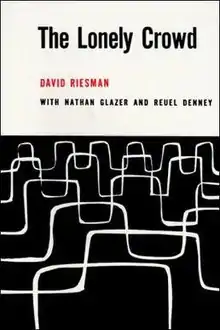The Lonely Crowd
The Lonely Crowd is a 1950 sociological analysis by David Riesman, Nathan Glazer, and Reuel Denney. Together with White Collar: The American Middle Classes (1951), written by Riesman's friend and colleague, C. Wright Mills, it is considered a landmark study of American character.[1]
 | |
| Authors | David Riesman Nathan Glazer Reuel Denney |
|---|---|
| Country | United States |
| Language | English |
Publication date | 1950 |
| Media type | |
Description
Riesman et al. identify and analyze three main cultural types: tradition-directed, inner-directed, and other-directed. They trace the evolution of society from a tradition-directed culture, one that moved in a direction defined by preceding generations. Tradition-directed social types obeyed rules established a long time in the past and rarely succeeded in modern society, with its dynamic changes. This earliest social type was succeeded by people who were inner-directed. They discovered the potential within themselves to live and act not according to established norms but based on what they discovered using their own inner gyroscope. Inner-directed people live as adults what they learned in childhood, and tend to be confident, sometimes rigid. After the Industrial Revolution in America had succeeded in developing a middle-class state, institutions that had flourished within the tradition-directed and the inner-directed social framework became secondary to daily life. Instead of living according to traditions, or conforming to the values of organized religion, of the family, or societal codes, the new middle class gradually adopted a malleability in the way people lived with each other. The increasing ability to consume goods and afford material abundance was accompanied by a shift away from tradition to inner-directedness. How to define oneself became a function of the way others lived.
Gradually an other-direction took hold, that is, the social forces of how others were living—what they consumed, what they did with their time, what their views were toward politics, work, play, and so on. Riesman and his researchers found that other-directed people were flexible and willing to accommodate others to gain approval. Because large organizations preferred this type of personality, it became indispensable to the institutions that thrived with the growth of industry in America. As Riesman writes, "The other-directed person wants to be loved rather than esteemed", not necessarily to control others but to relate to them. Those who are other-directed need assurance that they are emotionally in tune with others. By the 1940s, the other-directed character was beginning to dominate society. Today the triumph of this type of social personality is complete. If one applies the other-direction criteria to everyday actors as portrayed in modern culture, for example, the other-directed person is easy to identify.
This defined the middle class that no longer had the material needed to cling to past life standards to form a cohesive society. But since the other-directed could only identify themselves through references to others in their communities (and what they earned, owned, consumed, believed in) they inherently were restricted in their ability to know themselves. Riesman's book argues that although other-directed individuals are crucial for the smooth functioning of the modern organization, the value of autonomy is compromised. The Lonely Crowd also argues that society dominated by the other-directed faces profound deficiencies in leadership, individual self-knowledge, and human potential. The book's title was chosen by the publisher, not by Riesman or his co-authors, Nathan Glazer and Reuel Denney.
References
- Gitlin, Todd (May 24, 2002). "David Riesman, Thoughtful Pragmatist". The Chronicle of Higher Education. Retrieved 2006-11-29.
External links
- Fulford, Robert (July 3, 2002). "The Lonely Crowd (review)". The National Post. Retrieved 2006-11-29.
- David Riesman; Nathan Glazer; Reuel Denney (2001). The lonely crowd: a study of the changing American character. Yale University Press. ISBN 978-0-300-08865-6. (reprint)
- Geary, Daniel. "Children of The Lonely Crowd: David Riesman, the Young Radicals, and the Splitting of Liberalism in the 1960s," Modern Intellectual History, Nov., 2013, Vol. 10, Issue 3, pp. 603–633